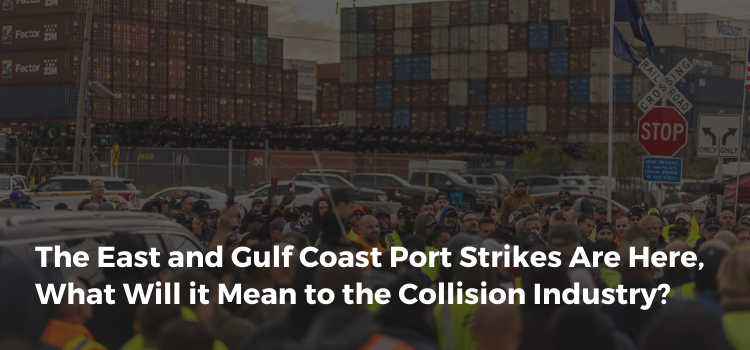The East and Gulf Coast Port Strikes Are Here, What Will it Mean to the Collision Industry?

As we anticipated from our August blog: Is an East and Gulf Coast Port Strike Inevitable and What Will it Mean to the Collision Industry?, the International Longshoremen’s Association (ILA) went on strike on October 1st, impacting seven of the ten busiest U.S. ports on the East and Gulf Coasts. With nearly 50,000 members participating, the strike is expected to have a significant economic impact, potentially surpassing last year’s strike at the Port of Los Angeles and Port of Long Beach. Between 43% to 49% of all U.S. imports and billions of dollars in trade monthly pass through these ports, highlighting the potential disruption to the flow of goods. This work stoppage could be one of the most disruptive in decades, affecting the import and export of goods in the nation and potentially leading to significant economic consequences.
Bad Timing
The strike occurring at this time will significantly worsen the current supply chain congestion already caused by Hurricane Helene. The hurricane resulted in suspended operations at ports in Charleston and Savannah, as well as power outages at intermodal facilities in Savannah, Charleston, and Atlanta. This has led to congestion for ocean, trucking, and rail carriers across Southeast and Gulf ports. The combined impact of the strike and the aftermath of the hurricane will further disrupt and exacerbate the challenges already facing the supply chain operations in the region.
The Impact
The ILA strike has resulted in a walk-off, rather than a slow-down, shutting down ports along the Gulf and East Coast. This has stopped imports and exports flowing through these ports, including total loss salvage vehicles destined for rebuilders overseas. While large aftermarket suppliers in the U.S. believe they have enough inventory to last over two months, OEM component imports and new vehicle shipments from Europe will be significantly impacted. Many suppliers had already rerouted additional inventory through the west coast ports in anticipation of the work stoppage. The strike is causing major disruptions to the flow of goods and will have significant implications for various industries reliant on these ports for their supply chain.
USMX & The Union
The negotiation between the United States Maritime Alliance (USMX) and the union representing the workers has resulted in a significant gap in their respective contract proposals. The USMX has offered wage increases of more than 50% over a six-year contract, while the union is seeking an annual $5-an-hour pay increase over the same period, equating to a 77% pay increase over the life of the contract. The USMX represents major shipping lines, terminal operators, and port authorities, all of which are foreign owned. The disagreement highlights the significant differences in the parties’ positions, and the potential for prolonged negotiations to reach a resolution. The outcome of these negotiations could have implications for the maritime industry and the workers involved.
No Indication of Sympathy Strike from West Coast Port Workers
The West Coast Port workers, represented by the International Longshore Workers Association, have pledged solidarity with other workers, but have not indicated any plans to walk off the job. This is due to the six-year contract they negotiated last year, which includes provisions for dispute resolution. As a result, the Port workers are bound by the terms of the contract and are expected to continue their work.
West Coast Ports Say They Have Capacity
According to Port of Los Angeles Spokesman Phillip Sanfield, the Port of L.A. and importers have been planning for the possible walkout for months. “This is not a surprise — this labor disruption,” Sanfield said in an interview Monday morning. “Importers have been watching this closely and have been fractionally moving cargo to the West Coast for the last six, seven months. So, we’ve had an uptick in cargo here.” He noted the potential capacity of the Port of L.A., saying that it typically operates at 70% to 80% capacity. It’s currently at 80% capacity. Sanfield indicated that despite the record container volumes over the past few months, operations at the Port of Long Beach container terminals remain fluid. The port is handling just as much cargo as we did in 2021 and 2022, but without any of the pandemic-era backlogs, delays or congestion that arose due to issues outside the port.”
What To Look For
A strike lasting more than five weeks will have significant implications for the collision parts supply in both aftermarket and original equipment (OE) parts. The longer duration of the strike will lead to lower demand parts with reduced inventory levels being affected, as the replacement process will take longer. Moreover, OE components from Europe will have to travel via the Panama Canal, potentially resulting in delays at Parts Distribution Centers. This will create competition for container space, further impacting the replenishment of slower moving stock. Overall, the prolonged strike will disrupt the supply chain and lead to delays in the availability of collision parts for the industry.
Stay informed on the latest updates regarding the East and Gulf Coast Port strikes by regularly checking the PartsTrader blog. We will continue to provide important information to keep you updated.
